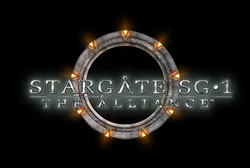Cancelation and legal dispute
On May 10, 2005, publisher JoWood announced the closing of a distribution agreement with Nobilis IBERICA, that would give Noilis distribution rights of JoWood titles, including Stargate SG-1: The Alliance, in Portugal and Spain. [78] [79] The following week, JoWood also announced its partnership with Namco, who would release the game in the USA. [80] [81] [82] [83] According to Lenzo, all sub-licensing of the game had to be approved by Perception, and chiefly by MGM. JoWood mistakenly sent both Perception and MGM a copy of the contract which had been "signed a month before" by Namco, instead of a draft contract. This now meant that Perception had unknowingly breached their contract with MGM by letting JoWood sub-license, with Lenzo claiming that "shit hit the fan" but that ultimately they went forward with Namco. [45] After meeting members of the Namco team at E3 in May 2005, Lenzo then learnt that Namco had been told by JoWood that it was them who held the rights to the Stargate game and had the relationship with MGM, not Perception. [45]
In July 2005, Lenzo traveled to Austria to meet with JoWood, who had not been paying Perception and had been in breach of their contract since December 2004. [45] [84] JoWood, had been restructuring for some time, with their founder Andreas Tobler being replaced by Dr. Albert Seidl in January 2005 due to "the clear failure to meet the sales targets in 2004". [85] In their meeting, Lenzo alleged that he was told by Seidl that JoWood "would have gone under" had Perception pulled the contract from them. Lenzo "didn't want to be held responsible for 30 people losing their jobs" so gave them until August 5, 2005, to pay, else Perception would terminate their contract. [45]
On the August 5 deadline JoWood announced that they had been "forced to cancel the development agreement with Perception, the Australian developer currently responsible for the Stargate SG-1: The Alliance". [86] [87] With the game scheduled to be released that October and Seidl claimed that in its current form it did not "satisfy neither our quality requirements nor the fans expectations", going on to state that JoWood had lost confidence in Perception's ability to finish the game "in time and sufficient quality". [88] In JoWood's statement, they announced their expectation of "repayment of their investment in development and further expenses" and that rights to the title and game assets would be transferred to JoWood where they would review the possibility of continuing work with another developer. [89] [90] [91]
The following week on August 12, 2005, Perception put out their own press release stating that as the licensee, they were continuing development of the game writing "any suggestion that JoWooD has rights to Stargate SG-1: The Alliance upon termination of the contract is incorrect and not based on commercial or legal fact". [92] [93] [94] [95] They went on to announce that they would take legal action against JoWood CEO Albert Seidl and the companies chairman of the supervisory board, Andreas Rudas for libel. [84] [96] [97]
On August 29, 2005, the hearing began in the regional court of Leoben, Austria, with Perception seeking to have JoWood declared bankrupt. [98] JoWood CEO Dr. Albert Seidl meanwhile countered he had the right to terminate the contract and that Perception owed them EUR 5.5 million for the development of the game. [99] [100] The motion to have JoWood declared bankrupt was rejected by the judge on September 7, 2005. [101] [102] JoWood announced that they had filed a fraud report against Perception on October 3, 2005, and were seeking to reclaim the EUR 5.5 million they had invested in the game, citing that Perception had been unable to delivered the game to the desired quality in the agreed time frame. [103]
According to Lenzo, Namco had still been happy with distribute the game in the United States until JoWood continued to claim ownership over the game which lead Namco to cut all ties. [45] Perception then had 3 publishers interested in taking over, but Lenzo commented that MGM wouldn't approve them. [45] In January 2006 Perception ceased development of Stargate SG-1: The Alliance having run out of money and been unable to have MGM approve a new publisher. [104] [105] [106]
Perception then filed another lawsuit against JoWood in November 2007 for damages of EUR 8 million. [107] [108] [109] [110] In the private prosecution of Albert Seidl and Andreas Rudas for alleged credit-damaging statements, the Vienna Regional Court found Perception's allegations to be inaccurate in June 2008, although this was not final. [111]







